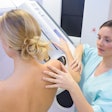
Despite the recent emphasis on the importance of shared decision-making between women and their doctors regarding mammography screening, primary care providers are ill-equipped to discuss the topic, according to a study published online June 28 in the Journal of Women's Health.
The issue is particularly fraught for women younger than 50, for whom many organizations, such as the U.S. Preventive Services Task Force (USPSTF), do not recommend routine mammography screening, wrote a team led by Kathryn Martinez, PhD, of the Cleveland Clinic.
"Providers are patients' most important information source regarding mammography," Martinez and colleagues wrote. "[Yet] our findings suggest that many providers may not be sufficiently prepared to engage younger women in this important [discussion]."
Can we talk?
The USPSTF recommends that mammography screening begin when a woman is 50 and continue every other year until she is 74. For women younger than 50, the task force recommends that healthcare providers invite their patients to a "shared decision-making" process -- an approach designed to help women decide when to begin mammography screening based on a thorough understanding of its benefits and harms, the authors wrote.
But this strategy is contingent on the ability of primary care providers and other referring physicians to initiate this kind of discussion.
 Kathryn Martinez, PhD, from the Cleveland Clinic.
Kathryn Martinez, PhD, from the Cleveland Clinic."To effectively engage younger women in shared decision-making for mammography, providers must have accurate knowledge of screening benefits and harms, [have] adequate time to discuss screening with patients, and feel competent at doing so," the group wrote.
To assess physicians' capacity to discuss the pros and cons of mammography with their patients, Martinez's group conducted an online survey in 2015 of primary care providers, asking respondents about their knowledge of mammography screening benefits, as well as what some say are its harms -- such as the risk of additional imaging, biopsy, or overtreatment.
Survey participants reported the length of time they typically spend with patients discussing mammography, assessed their own competence in talking to patients about screening, and shared their perspective on shared decision-making for mammography. The researchers invited 612 providers and received 220 responses.
Martinez and colleagues found that 90% of survey respondents underestimated the possibility of additional imaging following mammography, while 82% underestimated the possibility of breast biopsy. As for approximating mammography screening's effect on mortality, 62% of survey participants were correct.
Most respondents (83%) believed that shared decision-making for mammography was a good idea, but the majority (77%) spent fewer than five minutes with patients discussing screening. Of those who believed that discussing screening mammography with patients was beneficial, only 10% had key mammography knowledge and felt competent to talk to women about screening.
Providers are more inclined to counsel women on the benefits of screening rather than its harms, and it's unclear whether this is due to "inadequate knowledge" of these harms or providers' support for screening despite them, the authors noted.
"In cancer screening discussions, benefits are often emphasized over harms," they wrote. "We found providers' estimates of common harms to be generally inaccurate. Almost none correctly estimated a woman's risk of being called back for additional imaging and most underestimated the risk of needing a biopsy, despite these being the most common harms of screening."
What's a harm?
It's up to women to decide whether getting called back for additional imaging or a biopsy after a mammography exam is harmful or not, Martinez told AuntMinnie.com. And that's why primary care providers need to be able to thoroughly discuss screening mammography with their patients.
"Women need to have a realistic idea of screening mammography so they can make the best decision for them, and that means providers need to be equipped with accurate information," she said.



















